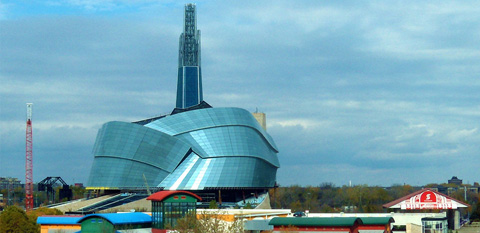Canada’s new human rights museum shares oral histories
Canada’s new human rights museum shares oral histories –

WINNIPEG, Canada (AFP) – A new museum in Canada’s western prairies has amassed a unique collection of personal stories from genocide survivors, human rights defenders and others, and wants to share them.
Dedicated to the 60-year-old notion of human rights, a singular but intricate ideal, the Canadian Museum for Human Rights in Winnipeg, Manitoba will open its doors on Nov. 11.
It was conceived by now-deceased mogul Izzy Asper, who once controlled CanWest Global Communications Corp, one of the world’s largest media empires.
Over the past 15 years, the project has attracted both praise and protests, mostly from groups disappointed that their stories would not be included.
A third of the museum’s staff including curators quit ahead of its grand opening, complaining that its content had been sanitized, while administrators struggled with staggering cost overruns and funding shortfalls.
But since the museum started previewing a handful of its 11 galleries in September, the criticism has faded.
“We’re not a collections-based museum. Our main focus is to tell stories,” spokeswoman Maureen Fitz said.
“But there are more stories than we can tell.”
“Most rights museums commemorate specific events,” she added. “Our focus is on human rights as an aspirational idea, using the stories of defenders, victims and others to illustrate it.”
250,000 Visitors
The CA$351 million (US$312 million) museum designed by American architect Antoine Predock is one of the most anticipated works of architecture in Canadian history.
Built of polished concrete, basalt rock, limestone and alabaster wrapped in a wall of glass that “weaves light through darkness,” it seeks to frame how an expected 250,000 visitors each year will think about human rights by “offering multiple perspectives from different angles, which is also important in exploring human rights,” Fitz explained.
The site in downtown Winnipeg was chosen for the city’s legacy at the crossroads for labor rights, suffrage, minority language rights and indigenous people’s land rights in Canada.
Visitors are presented with interactive videos, photographs and text chronicling Canadian and world history’s “dark and bright spots” as they meander up a 23-story spiral pathway.
There are 181 oral histories of survivors of mass atrocities and people who fought rights violations.
Displays cover the Holocaust, the Armenian Genocide and other atrocities recognized by Ottawa, and identify patterns in them.
Tales are told of the First World War internment of Ukrainians, of the Japanese immigrant steamship Komagata Maru being turned away from Canadian shores in 1914, and of the 1919 Winnipeg General Strike.
Along the path, visitors can probe a smattering of artifacts, including a ballot box from Nelson Mandela’s 1994 presidential run, wedding photos of gay couples, and the dress worn by Mareshia Rucker to the first racially integrated prom at the Wilcox County school in the U.S. state of Georgia last year.
